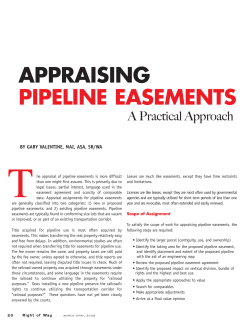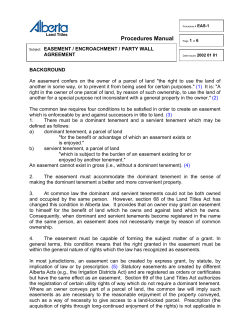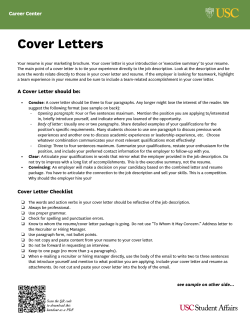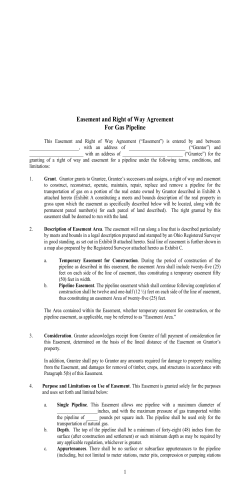
Pipelines & Right-of-Ways
Pipelines & Right-of-Ways Answers to commonly asked questions & guidance for those living or working near a Phillips 66 Pipeline LLC pipeline Help protect people, property and the environment by keeping rights-of-way on your property free of structures, landscaping and other obstructions. What is an Easement? An easement is a legal interest in land owned by another party, consisting in the right to use the land for a specific purpose. An easement allows the easement holder access to all or a portion of the property for a specific reason. The easement holder typically has the right to access the property contained within the easement borders and to place certain restrictions on how the property can be changed, maintained or used. An easement is often created through a written legal agreement with a property owner. The easement “goes with the land,” meaning that when the property is sold, conveyed or subdivided, the new owners of the property continue to be bound by the easement agreement. Pipeline companies hold an easement on properties along the path of the pipeline, intended to ensure the safety of the pipeline and guarantee access to it for operation, repairs, maintenance, inspection, or in the event of an emergency. The pipeline itself is generally located approximately in the middle of the easement and buried three feet underground. However, a pipeline may be located anywhere within the easement borders and its location within the easement may vary within a given property. It is critical to call 811 prior to any excavation so that the exact location of the pipeline can be marked. What is a Right-of-Way? The term right-of-way is often interchangeably used with easement. More specifically, it refers to a right granted as a result of an easement agreement. In this case, Phillips 66 Pipeline LLC has a right to enter or cross another’s property to install, inspect, repair, replace, operate and maintain equipment located on, or that crosses through, the property. A pipeline’s right-of-way is considered to extend along, across, below and above its pipeline easement. Right-of-Way Ownership A right-of-way is a property right and it grants the company certain rights to use the property to install, inspect, repair, replace, operate and maintain the pipeline, but not to “possess,” buy or sell your property or determine your ability to do so. However, the company may have the right to transfer or convey the easement agreement to other parties in the future, without notice to, or agreement by, the property owners. The pipeline company owns the pipeline and equipment that support, controls and protects it. While a landowner may own real estate surrounding the pipeline, he or she neither owns nor is responsible for any portion of the pipeline itself. Moreover, property owners are legally prohibited from activities that could interfere with the safe operation of the line. Right-of-Way Access Under our written easement agreements, Phillips 66 Pipeline LLC and its contractors have the legal right to access and inspect the easement, and to cross other areas of property, when necessary, to gain access to said easement. The agreement may provide that this access will occur only at reasonable hours and notice to the property owner, except in an emergency situation. Right-of-Way Size Phillips 66 Pipeline LLC written pipeline easements vary from property to property. The width of the easement was determined when it was originally purchased from the property owner prior to construction of the pipeline, or by law, though it may be modified by subsequent agreements. Phillips 66 Pipeline LLC can advise of the location and description of each of its pipeline easements. Right-of-Way Encroachment Under an easement agreement, Phillips 66 Pipeline LLC and its contractors have the legal right to protect its pipeline, which includes the right to prevent right-of-way encroachment and to remove or modify any trees, vegetation or other structures that impair the operator’s ability to carry out the purposes contained in the easement. Encroachments are obstructions that can limit or impair a pipeline operator’s ability to effectively update, repair, replace and maintain pipelines in a safe operating environment. Examples of common encroachments include buildings, patios, swimming pools, septic systems, This document is for informational purposes only and does not replace, substitute or preempt any interaction or agreements with Phillips 66 Pipeline LLC or its representatives. For specific information, including state-specific questions, contact 800-231-2566. 1 trees and fences. Many pipelines were constructed before federal pipeline safety regulations were enacted to promote safer pipeline operations. Before these regulations took effect, pipeline operators experienced many encroachments on their pipelines and rights-of-way. Congress has since granted the U.S. Department of Transportation with regulatory oversight of regulated pipelines. Phillips 66 Pipeline LLC and other operators now have guidelines that provide for the implementation of an encroachment program that meets federal pipeline safety standards. Phillips 66 Pipeline LLC’s encroachment program includes: • Providing for greenbelts along rights-of-way • Building setbacks • Utility crossing standards • Adequate cover over our pipelines Our pipelines are covered by written easement agreements that provide for reasonable legal protection against unacceptable encroachments and are filed as public records in the counties and parishes where we operate. We require advance review and approval of construction plans that impact our established easements. Maintaining the Right-of-Way Maintaining a clear, accessible right-of-way is imperative for protecting the safety of our neighbors, community, environment and personal property. Trees, fences, storage buildings and other common encroachments can hinder an operator’s ability to inspect, maintain and respond to emergencies related to the pipelines. Trees and tree canopies: • Prevent operators from effectively monitoring pipelines to detect possible leaks or unauthorized excavation and development • Can impede emergency responder access in the event of an emergency • Can hinder our ability to conduct routine maintenance • Roots can cause damage to protective pipeline coatings and increase the risk of pipeline corrosion failures and leaks Because of this, Phillips 66 Pipeline LLC will periodically clear trees, limbs or other vegetation from rights-of-way to ensure our ability to inspect and maintain the line. When it is necessary to clear a right-of-way, Phillips 66 Pipeline LLC personnel will make reasonable efforts to notify and work with affected property owners and other stakeholders. Contact Phillips 66 Pipeline LLC at 1-800-231-2566 for more information about our encroachment prevention program and guidelines or to discuss a project with one of our right-of-way representatives. 2 The above images are examples of right-of-way encroachments. Both the pine tree and swingset are placed atop the right-of-way. Clearing the Right-of-Way Right-of-way clearing refers to the removal of trees, unacceptable vegetation, and structures or other encroachments within the right-of-way. It includes trimming any branches (tree canopy) that hangs over the right-of-way and could prevent clear aerial views of said right-of-way. Professional tree services and other contractors may be hired by Phillips 66 Pipeline LLC to perform clearing activities. Additionally, Phillips 66 Pipeline LLC land agents, inspectors and/or engineers may also be on-site during the clearing and restoration process. Phillips 66 Pipeline LLC usually incurs all costs associated with tree removal. In some cases, a fence or other structure outside of the right-of-way may need to be removed to bring in equipment. In those instances, Phillips 66 Pipeline LLC will replace items when deemed appropriate. Prior to the start of clearing activities, a company representative will make a reasonable effort to discuss clearing operations with property owners. If personnel is unable to have a face-to-face discussion, material about the clearing operation is left at the property owner’s home, along with information on contacting Phillips 66 Pipeline LLC. If you are concerned that vegetation may be threatened, you may move trees and/or other vegetation to another part of your property. To do so, you must obey the law by dialing 811 to have a local One-Call service mark underground utility lines for free. You will be entirely responsible for the cost of this project. Due to the known proximity of the vegetation to the line, you are willingly entering a high-risk excavation project. Like all excavation projects, it is illegal for you to proceed with this task without first calling 811. Excavation without first calling 811 may by a violation of law and subject to civil or criminal penalties and fines. This document is for informational purposes only and does not replace, substitute or preempt any interaction or agreements with Phillips 66 Pipeline LLC or its representatives. For specific information, including state-specific questions, contact 800-231-2566. Encroachment Guidelines Description Setback Requirement Buildings and other engineered structures or works, including but not limited 50 feet to: barns, sheds, pools, ponds, retaining walls, decks, etc. Paralleling utilities: sewer, water, electric, telecommunication, etc. 25 feet Paralleling fences 25 feet Paralleling roads 25 feet Non-paralleling utility poles 8 feet Non-paralleling fence posts 4 feet Cover/Grade Elevation Changes Minimum of 36 inches to 48 inches of cover required Minimum of 48 inches required at all road crossings Excessive fill over pipelines not allowed -- maximum of 72 inches cover allowed Utility Crossings Pass underneath with minimum 18 inches of clearance (24 inches for electric) Communication, television or electric encased in minimum Schedule 40 steel or PVC casing High-voltage electric lines covered with four inch thick and 24 inch wide concrete slab Warning tape installed over all foreign utility crossings Utility crossings where practicable at 90 degrees (but not less than 45 degrees) Additional Information and Resources It is imperative that you understand and share pipeline safety best practices with others living or working near pipeline rights-of-way. Visit the following industry and government sites for important safety references and educational materials. National Association of State Fire Marshal’s “Pipeline Emergencies” www.pipelineemergencies.com PHMSA Emergency Response Guidebook http://hazmat.dot.gov/pubs/erg/guidebook.htm National Pipeline Mapping System www.npms.phmsa.dot.gov Contact Phillips 66 Pipeline LLC Phillips 66 Pipeline LLC Headquarters 3010 Briarpark Drive Houston, Texas 77042 www.phillips66pipeline.com Non-Emergency Phone Number 800-231-2566 Emergency Phone Number 877-267-2290 Use your mobile device to instantly access and save Phillips 66 Pipeline LLC emergency information to your contact list by scanning the icon at left. Phillips 66 Pipeline LLC Emergency & Excavator Awareness Portal http://tc.pipelineportal.com/p66 Download a free scan app now at http://gettag.mobi. Pipelines and Informed Planning Alliance http://primis.phmsa.dot.gov/comm/pipa/landuseplanning.htm This document is for informational purposes only and does not replace, substitute or preempt any interaction or agreements with Phillips 66 Pipeline LLC or its representatives. For specific information, including state-specific questions, contact 800-231-2566. 3
© Copyright 2025





















